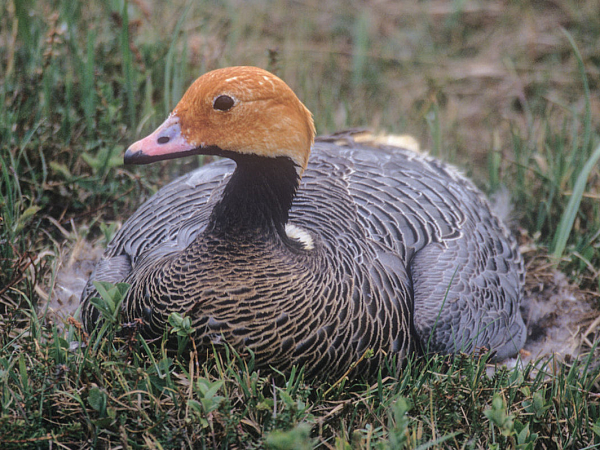
The regal Empress on her nest of down on the edge of a tundra pond.
|
This exciting week includes the longest days of the year, when the nesting season is in full force across the vast Arctic tundra. This week also marks an anniversary of my favorite week in the Arctic, which I timed to coincide with the peak of egg-hatching in the ultimate goose nesting location – the Yukon River Delta in western Alaska. In addition to nesting geese, there was a remarkable avifauna that included nesting Tundra Swans, Long-tailed Ducks, Spectacled Eiders, Black and Ruddy Turnstones, Black-bellied Plovers, Western Sandpipers, Red-necked Phalaropes, Sabine’s Gulls, Lesser Sandhill Cranes, and many more.
Among the nesting geese were Brant, Cackling, and White-fronted Geese, plus the elegant Emperor Geese! My primary goal for the week was to photograph an Emperor Goose while I shadowed biologists who were working in this tundra and wetland complex. I pitched my backpacking tent amid their seasonal tent camp as they studied the nesting birds deep within the Yukon Delta National Wildlife Refuge. It took me back to my Eagle Scout days of sleeping outdoors and going without a shower, although it’s different trying to get your days and nights separated when it never gets dark.
The Yukon River Delta is a remarkably attractive location for nesting birds, especially waterfowl and shorebirds. There, shorebirds act like completely different animals than we encounter to the south. All the sandpipers and plovers were singing while performing flight displays or perching from an elevated point to sing or call territorially. Same for songbirds like Lapland Longspurs and Snow Buntings; there is a constant chorus of bird sounds, and the abundant birdlife seems to be in constant motion.
Emperor Geese were relatively common in the area, but during the first couple days none presented an opportunity for more than a long-distance documentary photo or two. About mid-week, after miles of slogging cross the wet tundra in heavy hip waders, I made a “wrong turn” and became bogged down in the thick mud of a drying pond. As I struggled to pull myself out of the deep muck, I picked my way carefully to a firmer, grass-covered shoreline. My attention was still focused on the ground as I picked each of my steps carefully to assure that I didn’t get trapped in the muck again.
When I stopped a moment to catch my breath, I looked up to see something that made my excitement level jump as I gasped in surprise. Only a couple steps in front of me was a beautiful Emperor Goose pressing her body, neck, and head tight against the ground, concealing the goose-down nest beneath her. My heart was already pounding from the unexpected workout in the mud, but now my heart thumped even harder as I eased my backpack off my shoulder and removed my camera, which was fitted with a 100-to-300mm zoom lens.
I quickly composed the ultimate nesting Empress image and took the first couple photos, zooming in to get some full-framed images. Next, I carefully kneeled to get down to the goose’s eye level to take more photos as she raised her head as though less concerned with my bumbling advance. This was the ultimate Yukon Delta experience for me, and I made the most of it as I took some of my favorite photos of this impressive Emperor Goose.
At such close quarters – I was literally only 10 feet from the Empress – I could study the coloration of the bird with scrutiny. One feature that was so very obvious there in the nesting range, which is almost never illustrated in field guides, is the coloration of the head of Emperor Geese during summer. Field guides traditionally depict Emperor Geese with white heads; however, in the Yukon River Delta, where most of North America’s Emperor Geese nest, all the Emperors have orange heads because their white feathers are stained a rufous color by the tannin in the water of the tundra ponds. Perhaps someday my photographs will help to illustrate this seasonal variation to other ornithologists and birders, as well as field guide authors, photo editors, and publishers.
I thought to myself that this regal goose was remarkably trusting and most protective of her clutch. Then I heard the muffled peeping sounds that indicated that her valuable clutch of eggs was hatching, even as I stood nearby. Not wanting to concern the Empress any more with my presence, I slowly backed away and happily left her to care for her hatching brood of regal goslings during this important time in her nesting season.
How would I beat a royal experience like this, even in such an exhilarating wilderness setting? I more than fulfilled my goal for this trip, and I also reveled in the fact that I may have been the only person to photograph an Emperor Goose on her nest that year. What a thrilling Arctic experience!
Article and photograph by Paul Konrad
You can learn more about the Yukon Delta National Wildlife Refuge at https://www.fws.gov/refuge/Yukon_Delta/about.html
Share your birding experiences anytime at editors2tbw@gmail.com